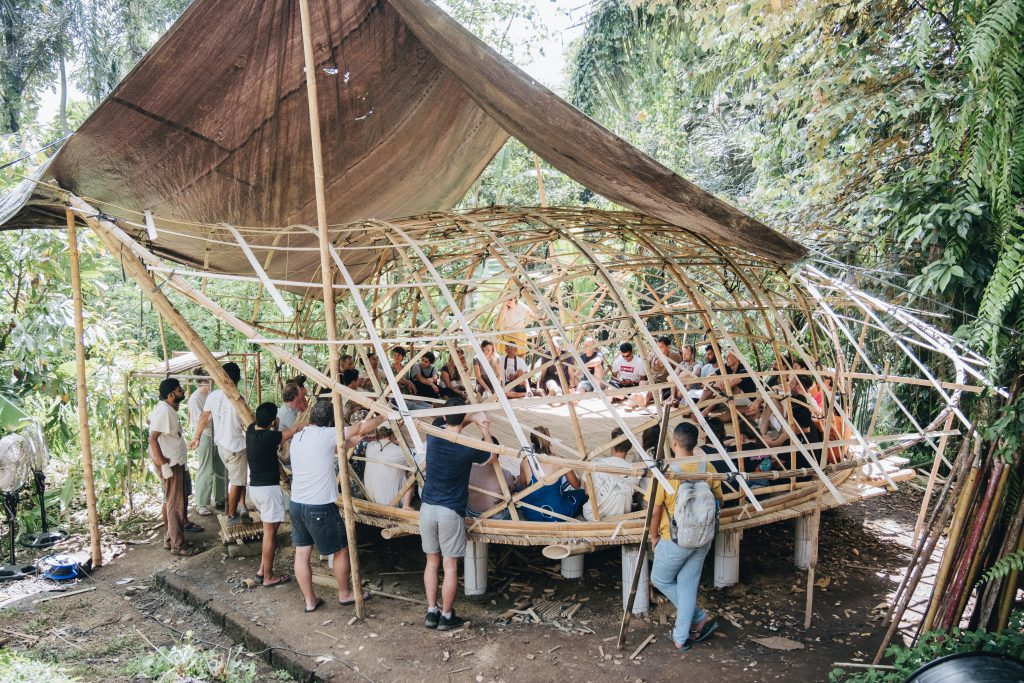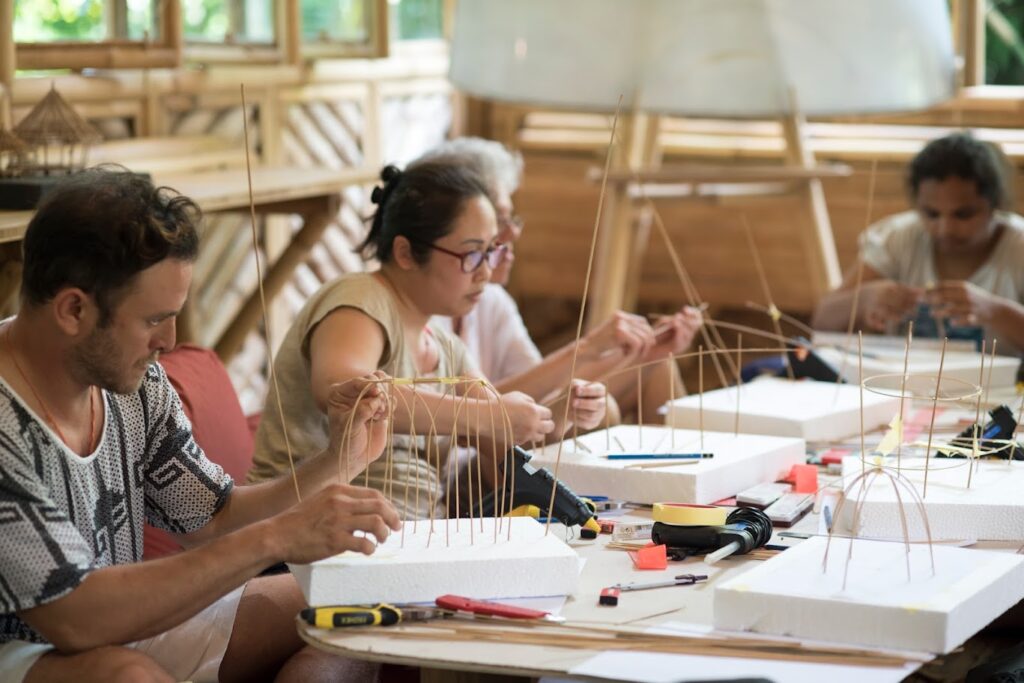The Use of Augmented Reality (AR) In Bamboo Architecture
By Rodrigo Istchuk | July 7, 2023 | Design - Construction -

Explore the transformative potential of Augmented Reality (AR) in reshaping bamboo architecture from design to construction and education.
With its unique blend of form, function, and sustainability, bamboo architecture stands apart with complex geometries, tridimensional spatiality, and a heavy reliance on craftsmanship. For many years, physical models have been central to materializing architects' visions and conveying intricate designs to the skilled craftspeople responsible for construction.
Now, we're in the midst of a paradigm shift. The digital revolution is bringing computer-aided and parametric design tools to the forefront, unlocking bamboo's potential in ways never before imagined. This evolution presents exciting possibilities and new challenges for builders and craftsmen alike.
The burning question now is: Can we effectively translate these cutting-edge design innovations to the hands-on world of the craftsmen who bring these visions to life?
At a recent 11 day Bamboo Build and Design Course at Bamboo U, we immersed ourselves in a world where technology meets tradition, experiencing the groundbreaking blend of bamboo construction and Augmented Reality (AR) technologies. Guided by the expertise of Dr. Kristof Crolla and Dr. Garvin Goepel from the University of Hong Kong and the Chinese University of Hong Kong, we embarked on an exciting journey to build not one, but two, charming grid shell domes, under the aid of holographic instructions.
In this article, we explore this dynamic intersection of tradition and technology in the world of bamboo architecture.
From CAD to Craft: The Augmented Reality Revolution
As we further delve into the digital era, Augmented Reality (AR) stands out as an innovative catalyst for reshaping the landscape of architectural practice. Unlike Virtual Reality (VR), which immerses users in a wholly digital environment, AR superimposes digital data onto our physical world. This subtle yet powerful distinction positions AR as an experience enhancer rather than a substitute for reality.

In the context of bamboo architecture, AR's appeal becomes particularly irresistible. By enabling in-site visualization of complex models, AR makes it possible to bridge the gap between designers and craftsmen. It goes beyond the limitations of traditional methods, providing a clearer depiction of design elements that can be challenging to convey on paper or in physical models.
In this sense, AR technology holds the potential to democratize craftsmanship by replacing technical jargon with intuitive, holographic instructions. This shift from drawing-based communication to immersive, AR-infused instruction paves the way for a future where anyone, regardless of professional training, can participate in the creation of elaborate bamboo structures.
Learning By Doing: AR's Game-changing Role in Bamboo Education
AR serves as a tool not just for design, but also for education and training within bamboo architecture. It helped to mitigate the distinction between student and craftsman, providing workshop participants with the digital resources to step confidently into the role of skilled artisans. As we’ve heard from some students during our course, “with AR, anyone can become a craftsperson”.
AR's role was integral from inception to the completion of our gridshell domes. It assisted with everything—from the precise marking of foundations and dome bases, preparation of the materials in the required dimensions, and grid assemblies on-site. After the dome was pop-up by students, AR was also useful to verify and adjust the dome's geometry. It was inspiring to watch AR technology reshape our perception of construction processes and fuel the hands-on instincts of the participants.




Embracing Tomorrow: The Future of AR in Bamboo Architecture
As we stand on the edge of an exciting new era in bamboo architecture, the role of Augmented Reality (AR) continues to expand and evolve. With its immersive and intuitive interface, AR has already demonstrated its potential to revolutionize both the design process and the craft of bamboo construction. But what does the future hold?

In the near term, we anticipate AR becoming an even more integral tool in the translation of digital bamboo design into manageable on-site instructions. More advanced algorithms and increased processing power will allow for the creation of more complex and innovative bamboo designs, while with AR, such visions will make their way more effortlessly to craftsmen and open the doors to uncharted architectural territories.
AR is also set to become a potent tool for collaboration. Architects, craftsmen, and clients alike will be able to simultaneously view and interact with 3D models in real-time. This shared digital workspace will foster better understanding, promote creative synergy, and streamline the decision-making process.
The transformative potential of AR goes beyond design and collaboration. On the construction site, AR will enhance precision and efficiency, reducing errors and waste. Builders will have access to real-time, step-by-step holographic instructions that seamlessly blend with the physical environment. This digital guidance will help craftsmen execute complex designs with precision, reducing the reliance on exhaustive training and facilitating the democratization of skill.
The future also holds immense potential for integrating AR with other emerging technologies. Imagine a world where drones equipped with AR capabilities fly over construction sites, assessing progress, identifying potential issues, and providing real-time feedback to the building team. Such a system could optimize the construction process, ensuring quality control while reducing time and cost.

As we look to the future, the possibilities seem endless. Augmented Reality is not just a tool; it's a catalyst for innovation, a medium for collaboration, a guide for craftsmen, and a mentor for aspiring bamboo architects. As we continue our journey, let's embrace this transformative technology and together shape the future of bamboo architecture.
If you’d like to learn more about current advancements in Augmented Reality research, we invite you to check the amazing work that’s being done by Garvin Goepel and Kristof Crolla, Bamboo U’s expert facilitators.
You can check Garvin’s work here: https://www.garvingoepel.com/
or on Instagram: https://www.instagram.com/augmentedarchitecture/
And Kristof’s work here: https://l-e-a-d.pro/
or on Instagram: https://www.instagram.com/lead.architecture/

Structural Engineer from Brazil, specializing in Bamboo Structures and Bio Architecture. With a multidisciplinary approach, Rodrigo has been teaching, designing, and collaborating with various Bamboo players around the world. For Rodrigo, bamboo is a tool to create meaningful change in people and the environment.
June 7-18, 2024
The 11 Day Bamboo Build & Design Course in Bali
In 11 days, we'll show you how to build bamboo structures we’ll share all that it takes to build with nature.
April 26, 2024
The Fundamentals of Building with Bamboo Online Course
All the fundamentals you need to get you started working with bamboo. Deep dive into cinematic videos and step-by-step guides that will provide you with a strong understanding of bamboo as a design and building material.
















